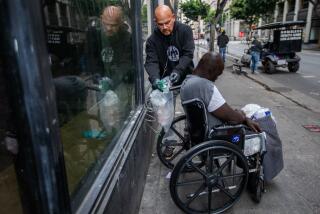High-Pressure Tactic : Decompression Chamber Treats Wide Variety of Problems
- Share via
Back when he was a Navy medical officer in the 1960s, Dr. John M. Alexander used decompression chambers to treat deep-sea divers suffering from the bends, a potentially fatal condition caused by surfacing too quickly.
Today, as director of the West Coast’s largest civilian decompression facility, at Northridge Hospital Medical Center, Alexander treats patients whose problems usually have nothing to do with diving.
They trickle into his two steel-walled, pastel orange chambers every day: diabetics with foot ulcers that don’t heal, cancer sufferers with radiation-induced tissue damage, victims of carbon monoxide poisoning.
In fact, divers represent only about 40 of the 240 patients who each year are sealed into Alexander’s chambers, which resemble railroad tank cars with portholes. Most other patients are those with “problem wounds”--lesions that conventional treatments fail to heal.
Such patients illustrate the changing nature of hyperbaric medicine, a controversial discipline in which patients inhale oxygen in a pressurized environment. Hyperbaric oxygen therapy, or HBO, is increasingly being employed against a dozen hard-to-treat ailments, including burns, crushed limbs and bone infections.
Only 37 clinical decompression facilities were operating in the United States in 1977, and there are nearly 260 today.
Yet the technique still struggles for acceptance among doctors put off by its quackery-tainted past and the scarcity of reliable data on its effectiveness against some maladies.
Hyperbaric oxygen therapy dramatically raises the oxygen level in a patient’s bloodstream, boosting the disease-fighting capacity of blood cells and promoting the healing of body tissue.
Although doctors report good results in treating their patients, and the therapy has been successful in numerous animal and some limited human studies, there have been few large-scale, controlled human trials.
The treatment has been shown to be highly effective in treating osteoradionecrosis, a breakdown of bone in cancer victims who have undergone radiation therapy. It is regarded as useful in treating carbon monoxide poisoning, crush injuries, gas gangrene and chronic osteomyelitis, a bone infection.
*
HBO is most widely used to treat problem wounds, such as diabetic foot and ankle lesions that fail to close.
As a group, diabetics undergo about 60,000 major amputations a year. Alexander said hyperbaric treatment, combined with a comprehensive wound care program, could save up to half of those limbs.
“We can resolve roughly 70% of the wounds,” said Alexander, who has been scuba diving since age 18 and helped developed safety guidelines for deep dives while attached to the Navy’s experimental diving unit.
“We don’t cure diabetes, we don’t cure vascular disease,” he said. “A lot of physicians say: ‘Show me the evidence.’ All I can show them is a series of diabetic (wounds) that have resolved.”
However, use of the therapy on problem wounds “remains an ill-defined field, and HBO data often consists of small (test) series without standardized patient populations or treatment schedules,” according to a 1990 article in the Journal of the American Medical Assn.
Hyperbaric treatment was first employed against non-diving diseases in the late 1950s, when surgeons in the United States and Europe began using pressurized operating rooms to carry out cardiovascular procedures that required temporarily stopping blood circulation.
With the advent of heart-lung bypass machines in the mid-1970s, surgeons abandoned the treatment. It was embraced instead by hyperbaric enthusiasts and charlatans who promoted it, with little or no scientific evidence, as a cure for heart attacks, wrinkles, arthritis, baldness and impotence.
*
Many doctors remain skeptical about the technique or unfamiliar with its beneficial uses. As a result, many patients who might benefit go untreated, experts said.
“When physicians see that kind of inappropriate use, they get a bad feeling about it,” said Dr. Tom Neuman, director of the hyperbaric chamber at the UC San Diego Medical School.
“But if you’re trained in an institution where everything is very critically analyzed and done in a scientific way, you’re going to have a different attitude about it.”
Although Alexander freely acknowledges the scarcity of solid human test data on hyperbaric therapy, as well as its “sordid past,” he said the treatment has benefited many of his patients, most of whom seek it after “everything else has failed.”
The cost can run from a few thousand dollars to nearly $50,000, depending on the number of chamber sessions, he said. Although most hospital hyperbaric units can handle only a few patients at a time, Alexander’s holds up to 20.
Alexander pointed to one former patient, Tommy Farrell of North Hollywood, a former actor who had throat cancer. Weeks of radiation therapy left Farrell with several mouth problems, including a persistent tongue ulcer.
“It hurt to talk. It hurt to swallow. Eating was a pain in the ass,” said Farrell, 72, who appeared in a string of Western movies.
Drugs failed to cure the ulcer and his doctors talked of amputating Farrell’s tongue. But after seven weeks of hyperbaric treatment, the ulcer disappeared.
“My God, the results were fantastic. Saved my life, I’ll tell you,” he said.
In addition to its individual patients, Alexander’s chamber has handled at least two cases of mass carbon monoxide poisoning.
In 1985, 200 students and five nuns at Mt. St. Mary’s College had to be evacuated from the West Los Angeles campus after a faulty gas heater developed a leak. Dozens were evaluated and treated by Alexander.
Most of those exposed suffered lightheadedness, nausea and some memory loss. But Alexander said the level of carbon monoxide in most victims’ blood was low, and they required only one session in the decompression chamber.
In November, two children died after a heater with a clogged vent spewed the deadly gas into a Palmdale home. Six other people in the house survived and were treated in the Northridge chamber.






